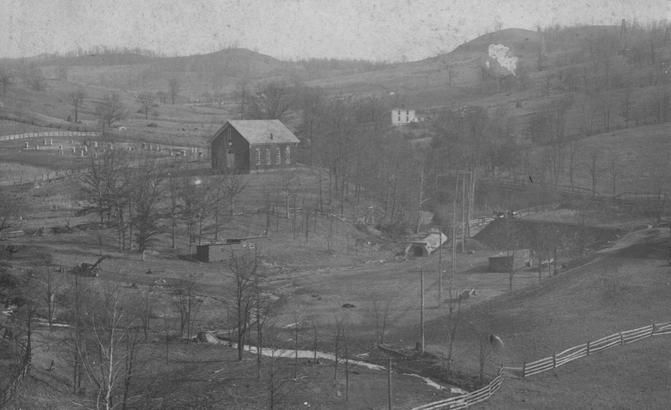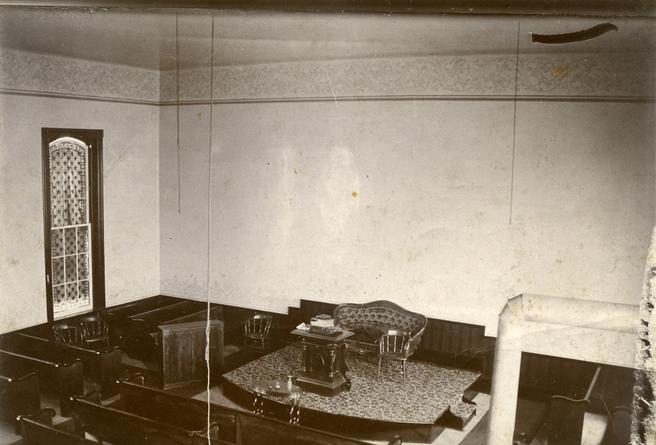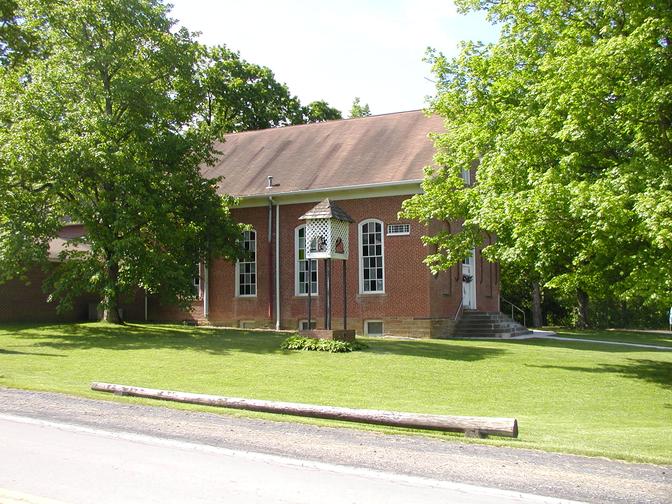
| Next Chapter | Previous Chapter | |
| Chapter 61: Our Old House | Contents | Chapter 59: More Nostalgia 3. A Trip Down Memory Lane, Route 19 from Clarksburg to Jane Lew |
During my childhood, every Saturday, which was known as Sabbath, my parents, sisters and I would dress in our best clothes and go to church. The church we attended was the Lost Creek Seventh Day Baptist Church. Both parents could trace their paternal line and membership in the church back to shortly after the Revolutionary War. At that time the frontier included the Allegheny plateau in Western Virginia .
The church had a little room near the entrance that informally was called the Spankin’ Room. When children were too restless or unruly while church was in session they were taken to that room, and when they were old enough to understand what they were doing wrong, and if they were recalcitrant, sometimes they were spanked. When I taught school I wished every child had that severe training in early youth to keep quiet for a while!
The church was the Lost Creek Seventh Day Baptist Church. It is very old by local standards. They had the Sesquicentennial in 1955, when I was 21. My direct ancestor, Richard Bond, and his family, who had moved from Cecil County, Maryland, in 1799 were founding members of the church. The building is a plain rectangular brick church. This is not the first building occupied by the church, two others proceeded it.
In some ways the church was much the same as it always had been. They practiced foot washing in the early days, when everyone was familiar with sweat and walking, but that had been dropped by the time of my youth, although some of the older members remembered it with some sentiment. I sometimes think about this practice when I come in tired and sweaty from farm work, and think about how good it feels to wash ones hands and face and neck. Testimony Meetings were held regularly, where individuals were encouraged to stand up and “testify” about their relation with the almighty. Once a visitor told folks in Lost Creek that the SDBs believed in “open confession,” which was quickly and firmly denied.
The polity was standard Baptist: minister chosen by the congregation, Associations of churches in various areas of the nation, Annual Conference of all the churches in the United States, Deacons (and later Deaconesses), to assist the Pastor and decide on matters of faith, church meetings of all members to decide on business matters, conducted by a Moderator and recorded by a Clerk. A lot of good feeling and mutual respect existed among members without regard for social status outside church, and there
(Illustration 60-1)

was considerable respect for learning. Most people in the congregation were related. It presented the liberal Baptist ideals of the time, although there were a number of renegade former Seventh Day Adventists in some of the other SDB churches, agitating for a more fundamentalist kind of religion.
One of the stories that goes with the Brick Church is that when it was being built the man who would now be called a contractor bragged in public that the church would never be able to pay, and he would have a tavern out of it. The idea that it would be a tavern was particularly repugnant to a church full of
(Illustration 60-2)

T-totalers. The guy began to lay up a wall to divide the church into two rooms. Of course, they refused to pay after this, and had to go to a magistrate to get the situation corrected. When that was done, they did pay, and the church was completed to the congregation’s satisfaction.
It burned in a few years, but the bricks were in sufficiently good condition that it could be rebuilt. Later, not long before my time, the congregation decided to build a basement under the church for dinners. The brick walls were very heavy, but under the foundation was solid rock. The basement was carved out of the solid, but soft, sandstone common in the area. There is a wide shelf at the top of the rock
(Illustration 60-3)

around the basement to support the walls.
Church members were still paying for the basement when I was a small child. They had a stand on the corner of the lot along the road next to the railroad track where meals were served on Sundays. Like the oyster suppers mentioned in section 34, it was largely a project of the women, with help from the men. Chicken was the main stay, with ice cream for desert. There was enough ice cream sold so that three or four freezers were made each Sunday.
Later, when I was a teenager, they decided to redo the front steps, remove the two maple trees in the middle of the front lawn, and build rest rooms. The men dug down around the two trees on each side in the front of the church and cut the roots with an ax. Dad had loaded his Ford 8N tractor on his one and a half ton Dodge truck and pulled the trees out with it. The tractor was for extra traction. Oris Stutler did the concrete work on the steps. The original cut stone steps had gotten in bad shape and are buried in the concrete. There was a wrought iron fence around the church, which was moved out to a few feet from the road to where it is today. I was a heavy, muscular kid, so they let me use the air hammer to break out the rocks excavating for the restrooms. Grandfather Kennedy told me that I had an eye for the cracks in the rock like a stonecutter. Grandmother Kennedy’s father was a stonecutter.
I left the Seventh Day Baptist church in one of the frequent schisms that characterize the Baptist church. The SDBs were a rapidly growing church on the frontier, comparable in number to the Methodists. They spread across the continent, but did not grow after a certain point. The loss of the SDB Theological School, which occurred about the time I went to college, and the shift toward fundamentalism, which I see as an oversimplification with an attempt to get power rather than truth, turned me off.
Fundamentalism is very good at developing power and attracting less thoughtful people, but it is selfish, offering easy “salvation” to individuals, but it characteristically lacks attention to ethics and community living. These had been strong in my youth. The doctrine of sanctification (the idea being that once a person is declared sanctified, that person could do no wrong) was characteristic of some frontier churches, but not the SDBs. At the present time sanctification seems to be implied in fundamentalism, without explicit statement. At least that’s the way many “saved” people act: gleefully take your money with no compassion, especially for opponents in business or war, “look down their noses” on their “unsaved” neighbors, and so on.
Also the local church developed a self-appointed Pope at about the time I left. I remember much of my adult life hearing my mother complain about the man and his wife, but she remained faithful to the church.
Aside November 28, 2001: Today I went to Clarksburg two times, once to see the lawyer afternoon, and once in the evening to see my failing mother-in-law. I set one fence post, repaired the electric fence around the lot the cattle are in, fed cattle on both farms, and cleared fifty feet of fence row with the tractor and the Alamo, a heavy duty flail mower.
| Next Chapter | Previous Chapter | |
| Chapter 61: Our Old House | Contents | Chapter 59: More Nostalgia 3. A Trip Down Memory Lane, Route 19 from Clarksburg to Jane Lew |
Copyright © 1998, 2006, 2008, 2011 S. Tom Bond (stombond at hughes.net)